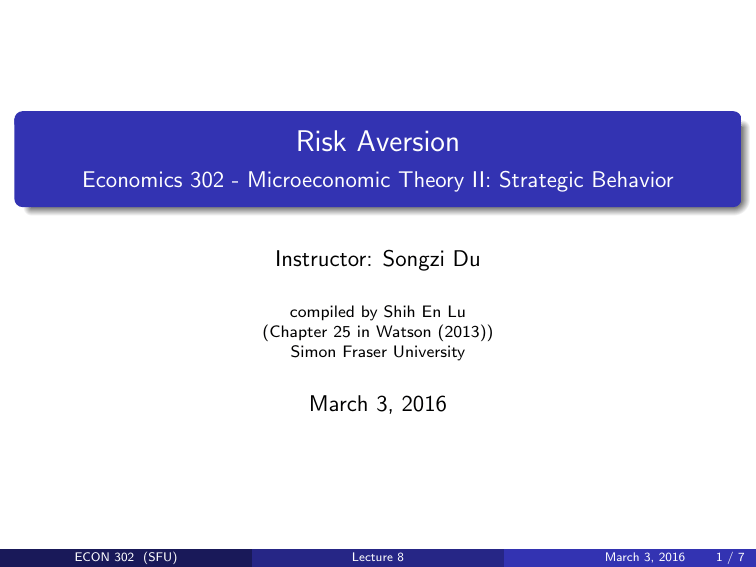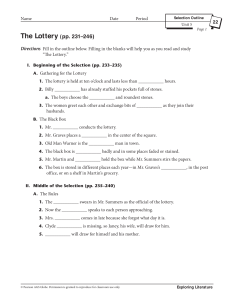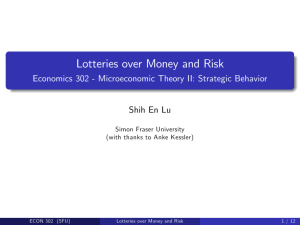Risk Aversion Economics 302 - Microeconomic Theory II: Strategic Behavior
advertisement

Risk Aversion Economics 302 - Microeconomic Theory II: Strategic Behavior Instructor: Songzi Du compiled by Shih En Lu (Chapter 25 in Watson (2013)) Simon Fraser University March 3, 2016 ECON 302 (SFU) Lecture 8 March 3, 2016 1/7 Objectives 1 Computing the expected value, expected utility and certainty equivalent of a lottery over wealth. 2 The shape of the utility function for risk-averse, risk-neutral and risk-loving agents. ECON 302 (SFU) Lecture 8 March 3, 2016 2/7 Utility over Wealth Recall that an agent’s expected utility from a lottery L with probability p1 of outcome 1 yielding utility u1 , p2 of outcome 2 yielding u2 , ..., pn of outcome n yielding un is: p1 u1 + p2 u2 + ... + pn un From expected utility theory, we know that under some assumptions, it is possible to assign ui so that the above function represents the agent’s preferences. But we didn’t say anything about how the ui ’s are assigned! Today: look at lotteries over wealth, and make assumptions on the utility. ECON 302 (SFU) Lecture 8 March 3, 2016 3/7 Definitions (I) Suppose you have utility u(·) over wealth and a lottery L = (p1 , p2 , ..., pn ), where outcome i is wealth wi , for each i = 1, ..., n. The expected value (EV) of L is: E [L] = n X pi w i i=1 (Sometimes, we are instead interested in the expected change in wealth (relative to your original wealth) under a lottery, which may be a bet/project/lottery ticket/etc. I will refer to that as the expected value of the bet/project/lottery ticket/etc. But the expected value of a lottery will refer to the expected total wealth, as above.) Your expected utility (EU) from L is: E [u(L)] = p1 u(w1 ) + p2 u(w2 ) + ... + pn u(wn ) ECON 302 (SFU) Lecture 8 March 3, 2016 4/7 Definitions (II) Your certainty equivalent (CE) for L is: w such that E [u(L)] = u(w ) You’re indifferent between L and having the CE for sure. Your risk premium for L is: E [L] − CE (L) √ Exercise: You have utility over wealth u(w ) = w and start with $50. Consider a bet with probability 0.5 of winning $14, and probability 0.5 of losing $14. Define the lottery associated with taking the bet. Find the EV of the lottery and of the bet. Find your EU, CE and risk premium for the lottery. Would you take the bet? ECON 302 (SFU) Lecture 8 March 3, 2016 5/7 Attitudes toward Risk An individual is risk-averse if CE (L) < E [L] (i.e. E [u(L)] < u(E [L])). An individual is risk-neutral if CE (L) = E [L]. An individual is risk-loving if CE (L) > E [L]. Sometimes, a lottery L is given, and you can define risk attitude with respect to L. If a specific lottery is not given, then the definitions above apply to all lotteries. For example, an individual is risk-averse if for any lottery L (where no outcome occurs with certainty), CE (L) < E [L]. ECON 302 (SFU) Lecture 8 March 3, 2016 6/7 Graphical Representation Remember the following math definition: a function u(·) is (strictly) concave if u(tx + (1 − t)y ) > tu(x) + (1 − t)u(y ) for all t ∈ (0, 1) and x 6= y . If you view x and y as outcomes of a lottery L = (t, 1 − t) over wealth, this just says u(E [L]) > E [u(L)]. In fact, you can show that this implication also holds for L’s with more than two outcomes. Therefore, risk-aversion ⇔ u(·) is strictly concave. Under the assumption that u(·) is twice-differentiable, risk-aversion ⇔ u(·) is strictly concave ⇔ u 00 (·) < 0. Similarly, risk-loving agents have strictly convex u(·), i.e., u 00 (·) > 0. Risk-neutral agents have linear u(·), i.e., u 00 (·) = 0. ECON 302 (SFU) Lecture 8 March 3, 2016 7/7










